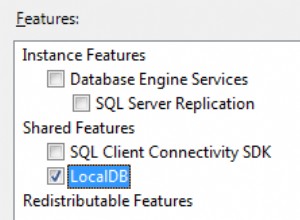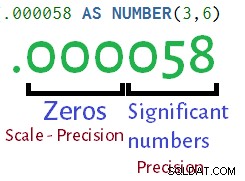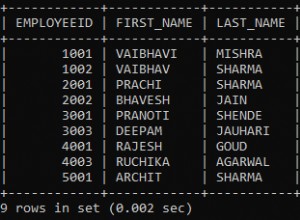Puoi usare unpivot/pivot per ottenere il risultato che desideri. Esistono diversi modi in cui puoi ottenere il risultato, se hai un numero limitato di valori, puoi codificare la query ma se hai un numero sconosciuto di valori, dovrai utilizzare SQL dinamico.
Il processo UNPIVOT convertirà le colonne multiple di c1 , ecc` in più righe. Una volta che i dati sono in più righe, puoi facilmente applicare la funzione PIVOT. Puoi utilizzare la funzione unpivot o APPLICA CROSS per convertire i dati da più colonne:
select id,
col = 'Service'+Service+'_'+col+'_'+cast(seq as varchar(10)),
value
from
(
select id, service, c1, cn
, row_number() over(partition by id
order by service) seq
from yourtable
) t
cross apply
(
select 'c1', c1 union all
select 'cn', cn
) c (col, value)
Vedi SQL Fiddle con demo . L'applicazione incrociata convertirà i tuoi dati nel formato:
| ID | COL | VALUE |
| 1 | ServiceA_c1_1 | 5 |
| 1 | ServiceA_cn_1 | 3 |
| 1 | ServiceB_c1_2 | 2 |
| 1 | ServiceB_cn_2 | 1 |
| 2 | ServiceA_c1_1 | 9 |
| 2 | ServiceA_cn_1 | 4 |
Una volta che i dati sono in questo formato puoi applicare PIVOT:
select id, ServiceA_c1_1, ServiceA_cn_1,
ServiceB_c1_2, ServiceB_cn_2
from
(
select id,
col = 'Service'+Service+'_'+col+'_'+cast(seq as varchar(10)),
value
from
(
select id, service, c1, cn
, row_number() over(partition by id
order by service) seq
from yourtable
) t
cross apply
(
select 'c1', c1 union all
select 'cn', cn
) c (col, value)
) d
pivot
(
max(value)
for col in (ServiceA_c1_1, ServiceA_cn_1,
ServiceB_c1_2, ServiceB_cn_2)
) piv;
Vedi SQL Fiddle con demo .
Quindi, se hai un numero sconosciuto di valori, puoi convertire la query precedente in SQL dinamico:
DECLARE @cols AS NVARCHAR(MAX),
@query AS NVARCHAR(MAX)
select @cols = STUFF((SELECT ',' + QUOTENAME('Service'+Service+'_'+col+'_'+cast(seq as varchar(10)))
from
(
select service,
row_number() over(partition by id
order by service) seq
from yourtable
)d
cross apply
(
select 'c1', 1 union all
select 'cn', 2
) c (col, so)
group by seq, Service, col, so
order by seq, so
FOR XML PATH(''), TYPE
).value('.', 'NVARCHAR(MAX)')
,1,1,'')
set @query = 'SELECT id, ' + @cols + '
from
(
select id,
col = ''Service''+Service+''_''+col+''_''+cast(seq as varchar(10)),
value
from
(
select id, service, c1, cn
, row_number() over(partition by id
order by service) seq
from yourtable
) t
cross apply
(
select ''c1'', c1 union all
select ''cn'', cn
) c (col, value)
) x
pivot
(
max(value)
for col in (' + @cols + ')
) p '
execute sp_executesql @query;
Vedi SQL Fiddle con demo . Entrambi daranno un risultato:
| ID | SERVICEA_C1_1 | SERVICEA_CN_1 | SERVICEB_C1_2 | SERVICEB_CN_2 |
| 1 | 5 | 3 | 2 | 1 |
| 2 | 9 | 4 | (null) | (null) |




